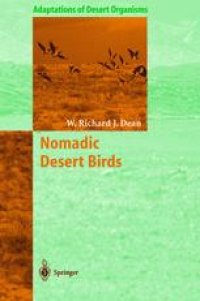
Ebook: Nomadic Desert Birds
Author: Dr. W. Richard J. Dean (auth.)
- Tags: Zoology, Behavioural Sciences, Animal Ecology, Animal Systematics/Taxonomy/Biogeography, Vertebrates
- Series: Adaptations of Desert Organisms
- Year: 2004
- Publisher: Springer-Verlag Berlin Heidelberg
- Edition: 1
- Language: English
- pdf
My interest in the behaviour and movements of birds of arid and semi-arid ecosystems began when my wife, Sue Milton, and I were Roy Siegfried, Director, at that time, of the Percy approached by Prof. FitzPatrick Institute of African Ornithology, to set up a project to investigate granivory in the South African Karoo. Sue and I spent some time finding a suitable study site, setting up accommodations and an automatic weather station at Tierberg, in the southern Karoo near the village of Prince Albert, and planning projects. Among our first projects was a transect where we noted plant phe nology, measured seed densities on the soil surface, counted birds, observed ant activity, measured soil surface temperatures and col lected whatever climate data we could at 40 sites along a 200-km oval route. Along the way, we became interested in the marked presence and absence of birds at certain sites - abundant birds one day, and very few birds at the same site a month later. Subsequent counts along fixed transects through shrublands confirmed that a number of bird species were highly nomadic over short and long distances, locally and regionally, leading to speculation on how widespread these movements were in the arid ecosystems of the world.
There are two basic strategies for coping with life in the desert. The first involves withstanding the extreme conditions using behavioural or physiological tactics. The second strategy is to be a migrant and to opportunistically or seasonally move to where the necessary resources are. Nomadism, i.e. the opportunistic and irregular movements from resource-poor to resource-rich patches, is a tactic that birds, with their mobility, can use, and it is explored by W.R.J. Dean in this volume. For many bird species, such movements between habitats or across landscapes to find patches of resources are essential for their continued existence. The relationship between climate, habitat and movements in the avifauna of arid and semi-arid regions and the advantages and disadvantages of a seasonally migratory or opportunistically nomadic lifestyle are elucidated.
There are two basic strategies for coping with life in the desert. The first involves withstanding the extreme conditions using behavioural or physiological tactics. The second strategy is to be a migrant and to opportunistically or seasonally move to where the necessary resources are. Nomadism, i.e. the opportunistic and irregular movements from resource-poor to resource-rich patches, is a tactic that birds, with their mobility, can use, and it is explored by W.R.J. Dean in this volume. For many bird species, such movements between habitats or across landscapes to find patches of resources are essential for their continued existence. The relationship between climate, habitat and movements in the avifauna of arid and semi-arid regions and the advantages and disadvantages of a seasonally migratory or opportunistically nomadic lifestyle are elucidated.
Content:
Front Matter....Pages I-X
Introduction....Pages 1-15
Migrations and Movements of Desert Birds....Pages 17-36
The Nomadic Avifauna....Pages 37-80
Habitats and Densities of Nomadic Birds....Pages 81-100
Food and Foraging....Pages 101-122
Reproduction and Moult....Pages 123-143
The Conservation of Nomadic Desert Birds....Pages 145-147
Back Matter....Pages 149-185
There are two basic strategies for coping with life in the desert. The first involves withstanding the extreme conditions using behavioural or physiological tactics. The second strategy is to be a migrant and to opportunistically or seasonally move to where the necessary resources are. Nomadism, i.e. the opportunistic and irregular movements from resource-poor to resource-rich patches, is a tactic that birds, with their mobility, can use, and it is explored by W.R.J. Dean in this volume. For many bird species, such movements between habitats or across landscapes to find patches of resources are essential for their continued existence. The relationship between climate, habitat and movements in the avifauna of arid and semi-arid regions and the advantages and disadvantages of a seasonally migratory or opportunistically nomadic lifestyle are elucidated.
Content:
Front Matter....Pages I-X
Introduction....Pages 1-15
Migrations and Movements of Desert Birds....Pages 17-36
The Nomadic Avifauna....Pages 37-80
Habitats and Densities of Nomadic Birds....Pages 81-100
Food and Foraging....Pages 101-122
Reproduction and Moult....Pages 123-143
The Conservation of Nomadic Desert Birds....Pages 145-147
Back Matter....Pages 149-185
....